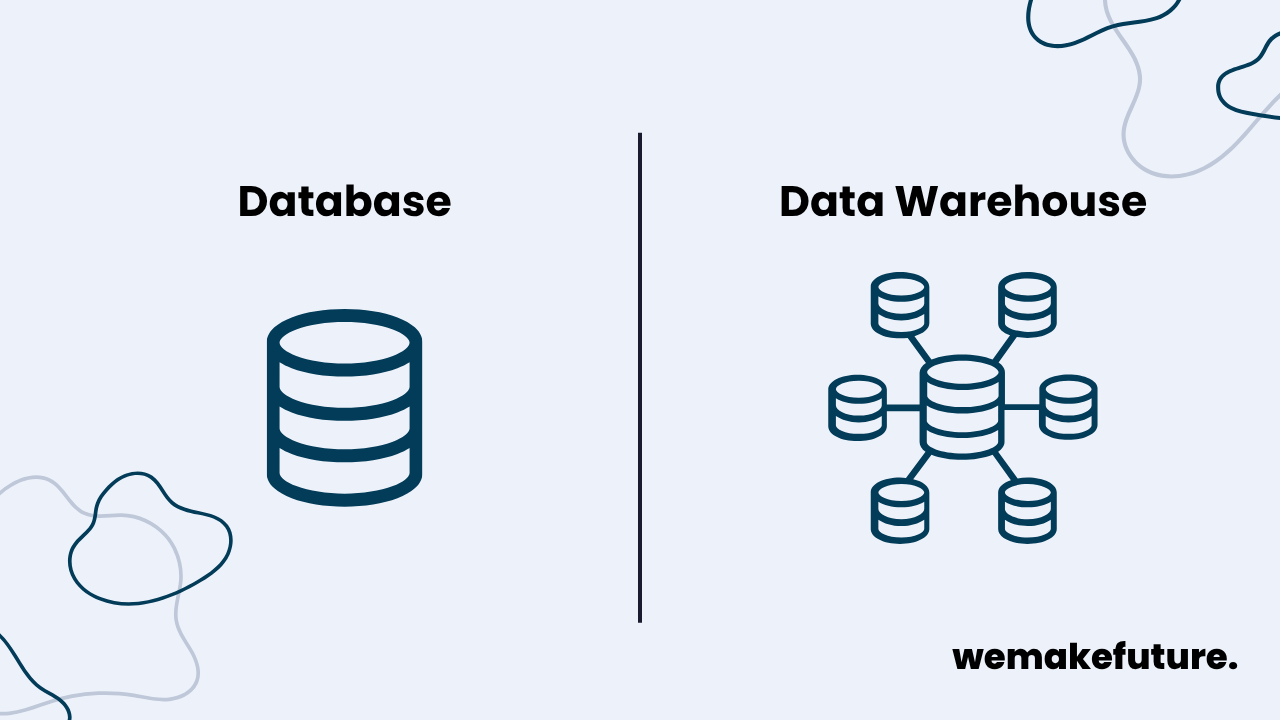
As businesses accumulate data over time, simply having more data doesn’t automatically lead to immediate solutions or optimized processes. Proper data storage and efficient analysis are both crucial. Data warehousing addresses these challenges by providing a structured way to store and analyze data. This enables organizations to effectively utilize their collected data, derive valuable insights from it, and make informed decisions to enhance their financial management, customer relations and more.
To understand the process of data warehousing, we first need to know the definition of a data warehouse. A data warehouse (DW or DWH), also known as an enterprise data warehouse (EDW), is a system designed for data analysis and reporting. Compared to databases, that mostly handle operational tasks with current data, data warehouses often contain large amounts of historical data from multiple data sources and consolidate them in one single place. This allows a historical record to form over time from which organizations can derive meaningful insights, making data warehouses a crucial element of business intelligence (BI).

Therefore, data warehousing is the process of gathering, organizing and managing data from various data sources for the purpose of analyzing the data to provide businesses with valuable insights and projections.
Data warehousing provides benefits beyond only insights and data analysis. Let’s take a look at some of its advantages:
Customers can be targeted with marketing campaigns or receive personalized recommendations by combining data from multiple sources and using them to generate detailed customer profiles and segments.
Customer, marketing, and sales data can also be analyzed to assess the success of campaigns. This can help pinpoint areas for improvement and increase ROI.
Examine supply chain data to determine any bottlenecks or inventory problems, then develop strategies to streamline manufacturing, distribution, and procurement procedures.
Financial data can be combined from various divisions or business areas to produce accurate financial reports. This can support financial analysis, budgeting, and forecasting.
Data warehousing can also be leveraged to implement ML and AI. Historical and real-time data can both be gathered to create algorithms that can forecast traffic spikes or offer personalized product suggestions to customers.
Implementing data warehousing for your business also requires reliable and scalable solutions that provide the infrastructure for storing large volumes of data. They need to be capable of unifying data and ensuring high performance for crucial data analysis. As with any product, the market is saturated with options available to you. To provide you with a quick overview, we have included a handful of the most often used data warehousing tools here.

Amazon Redshift is a fully managed, AI-powered, and Massively Parallel Processing (MPP) data warehouse solution from Amazon Web Services. The cloud-based tool runs real-time or predictive analytics on data and lets you focus on quickly gaining insights without the concerns of managing data warehouse infrastructure.
Amazon Redshift offers pay-as-you-go pricing, allowing you to begin with a free trial or as little as $0.25 per hour and scale up according to your business’s data and user needs.

Azure Synapse Analytics by Microsoft is a cloud-based analytics service for data warehousing and big data systems. It unifies SQL technologies used in enterprise data warehousing, Apache Spark technologies used for big data, Azure Data Explorer for log and time series analytics, and much more. It also allows integration with other Azure services, like Power BI.
Here, too, you can start with a free Azure account and then pay as you go, if you exceed the free monthly amounts. There are various tiers and discounts available as pre-purchase plans that scale with your specific needs.

Snowflake offers a cloud-based data storage and analytics service that allows users to efficiently store, share, compute, and clone data. The platform also provides scalability and support for third-party tools.
Snowflake offers a free trial as well as four pricing plans for either $2, $3, or $4 per credit or with custom pricing. These offer varying features such as optimized data storage, security with automatic data encryption, privacy controls, and backup recovery. The platform also provides users with on-demand storage for $23 per TB per month.
Data warehousing is a critical part of modern data analytics and business intelligence. By providing a structured approach to data storage and analysis and many more benefits, it enables businesses to efficiently manage and utilize their growing data volumes, effectively helping them optimize their business functions. Data warehousing can be applied in various areas of your business, allowing you to optimize your marketing campaigns or supply chain systems. It can even be integrated with AI or utilized to implement machine learning algorithms.
With the right tools, such as Amazon Redshift, Microsoft Azure Synapse Analytics, and Snowflake, businesses can leverage the full potential of their data, ensuring scalability, consistency, and improved decision-making capabilities.
Want to learn more about how data warehousing can benefit your business? We are always available for a free consultation to help you.
Stay up-to-date with us.